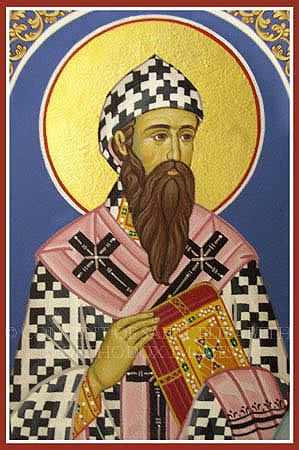Since Nestorius had stamped out his support structure, both religious and political, he was extremely vulnerable. In just over a year’s time, Nestorius’s ecclesial career crumbled around him. From the inauspicious sermon of Anastasias (November AD 428) to the declaration of Nestorius’ excommunication from the council at Rome (August AD 430), Nestorius’s ecclesial life abruptly collapsed. The Council of Ephesus convened in June of AD 431. The word “council” imbues a degree of structure and civility; however, this gathering of episcopals was anything but civil. Nestorius described the council in this way, “Cyril presided: Cyril was accuser: Cyril was Judge! Cyril was bishop of Rome! Cyril was everything.”[1] Though Nestorius had rallied substantial support from John of Antioch and Juvenal of Jerusalem, Cyril opened the Council before their arrival. Nestorius refused to appear at the council because Cyril obviously planned to condemn him. The end result of the Council of Ephesus was Nestorius’ excommunication.
everything.”[1] Though Nestorius had rallied substantial support from John of Antioch and Juvenal of Jerusalem, Cyril opened the Council before their arrival. Nestorius refused to appear at the council because Cyril obviously planned to condemn him. The end result of the Council of Ephesus was Nestorius’ excommunication.
The removal and exclusion of Nestorius was predicated by more than theological disputation. His position in Constantinople was already very tenuous because of his zeal for ecclesiastical reforms. This Council served to rally all of Nestorius’ enemies ensuring his demise. Soro summarizes that “Nestorius was a victim of imperial, ecclesial and political maneuvering among the Sees of Rome, Constantinople and Alexandria.”[2]
Nestorius was banished to his former monastery in Antioch and eventually to Upper Egypt. Despite the ecclesiastical setback, the followers of Nestorius[3] erupted from the Egyptian desert and became a powerful missionary enterprise which extended into the heart of China.[4] The fate of Nestorius was sealed after the Council of Ephesus and never again would he be viewed as a ecclesiastical patriarch.
In the years following the Council of Ephesus, Cyril’s repugnant characterizations of Nestorius gained wide acceptance. Susan Wessel describes Nestorius’ precarious situation after the council of Ephesus, “[Theodosius II] was so thoroughly disgusted with his former archbishop that he recoiled in horror at every mention of his name….He came to detest Nestorius [through] the influence of Plucheria, and [because] of the persuasive power of Cyril’s public sermons that portrayed Nestorius as an Arian and as a Jew.”[5] However, the theological deliberation over the nature of Christ’s incarnation was not over. Another council convened in AD 451 at Chalcedon and the primary issue was the incarnation of Jesus Christ. Soro correctly asserts that the Church’s developing theological terminology enabled the Chalcedonian Council to define the incarnation as ‘“one person in two natures’ [which was the exact realization that] Ephesus had failed to [articulate]: synthesizing and bring the two theological orientations to the closest proximity possible.”[6]
The Council’s theological affirmation adopted the term prosopon in its conciliar definition of the unity of natures maintained in the incarnation. Soro’s remarks, “the…definition [of the prosopon] guarded the permanence of the two natures in Christ, with all their properties and without change or confusion; the very theological objectives that Nestorius so fervently strove for.”[7] It is recorded that Nestorius agreed with Leo of Rome in regards to Chalcedonian Christology. Although urged by his compatriots to write to Leo stating his agreement thereby assuring his reinstatement, Nestorius
declined. He said, “I wrote not, not because I am a proud man and senseless, but so that I might not hinder from his running him who was

running fairly because of the prejudice against my person. But I was content to endure the things
whereof they accused me, in order that while I was accused thereof, they might accept without hindrance the teachings of the Fathers.”[8]
Nestorius’ concern for orthodoxy superseded his concern for personal reinstatement, which is a characteristic that should be emulated. Nestorius’ disparaging ecclesiastical career did not cause him to recoil at the faith he so dearly loved, but instead spurred him toward spiritual contentment in Christ. From a historical perspective, Nestorius is considered a heretic. However, through careful examination of Nestorius’ life and his Christological argument he should be seen more closely aligned with orthodoxy. When all was stripped away from Nestorius and he was near the point of death, he concluded the Bazaar of Heracleides with these words: “I have endured the torment of my life and all my fate in this world as the torment of the day and lo! I have now [come to the moment of death], and daily I beseech God to [release] me, whose eyes have seen the salvation of God. Rejoice for me, O desert, my beloved and my [provider] and the home of my habitation, and my mother the land of my exile, who even after my death will guard my body unto the resurrection by the will of God. Amen.”[9]
[1]Jenkins, Jesus Wars, 131.
[2]Soro, The Church of the East, 254.
[3]Philip Jenkins writes, “Nestorians remained very influential for over eight hundred years after the great church councils expelled them from the imperial fold, and they attracted believers over a huge geographical area. To put that achievement in context, that time span is far longer than the entire history of Protestantism to date.” See Philip Jenkins, The Lost History of Christianity: The Thousand-Year Golden Age of the Church in the Middle East, Africa, and Asia—and How It Died (New York: Harper One, 2008), 27-28.
[4]Philip Jenkins, The Lost History of Christianity: The Thousand-Year Golden Age of the Church in the Middle East, Africa, and Asia—and How It Died (New York: Harper One, 2008), x-xi.
[5]Susan Wessel, Cyril of Alexandria and the Nestorian Controversy (Oxford: Oxford University Press, 2004), 258.
[6]Soro, The Church of the East, 258.
[7]Ibid.
[8]Nestorius, The Bazaar of Heracleides, 378.
[9]Ibid., 380.